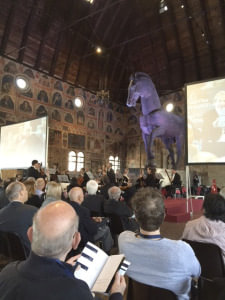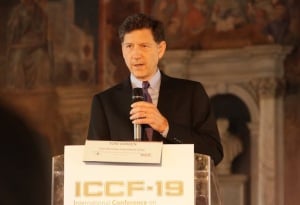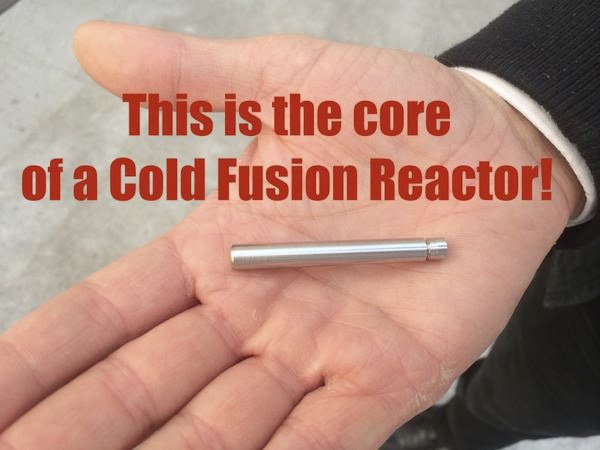The Need for Experiments
It’s been just 3 weeks since ICCF-19 concluded in Padua and one week since my return. I’ve been asked many times what I learned at this event and what was important.
Of course, that question is unfair: many important things occurred in the course of the week. I may not have actually appreciated the main significance of a good number of them. But for me, a highlight was seeing Dr. Alexander Parkhomov in person and watching his courageous response to the barrage of questions he received as he stood at his poster, his granddaughter by his side acting as interpreter.
Dr. Parkhomov delivered a Christmas gift to the world on December 25, 2014 when he published the video of his boiling-water demonstration of a Cold Fusion effect. Far too many words have been devoted on the Internet, such as on CMNS Google group chat site to the uncertain interpretation of the temperature measurements that he reported as being associated with this experiment. He reported, in fact, boiling water away to produce steam at a rate that maximized out at 2.74 to 1 over the amount of electrical energy that he was supplying to his unit. He did this with his ceramic stick version a ceramic “dog bone” reactor (using Rossi nomenclature) which glowed yellow hot at 1100° in his video (at 149:30 minutes into the first video). Notwithstanding the diversion on CMNS over his temperature measurements (the temperature profile that he reported over the time of his experiment), I’m still convinced that his 2+ to 1 measurement of energy as based on replacing boiling water, even if he did it with the kitchen measuring cup, is the most important event to have occurred in the past year.
Dr. Parkhomov was endeavoring to replicate the experiments done under the guidance of Andrea Rossi at Lugano, Switzerland in March, 2014, reported in October, 2014 by observers from Sweden. But Rossi never disclosed what his “magical ingredients” were. Dr. Parkhomov was quite open: powdered nickel and lithium aluminum hydride – LAlH4.
I largely accepted and believed the video that was posted on the Internet and the associated information provided by Dr. Parkhomov both at the time that it was released and subsequently. In contrast, others persisted in casting doubts on this entire demonstration because of the temperature data that had been provided. However, for me seeing this humble 70-year-old retired physicist from Lomonosov Moscow State University, Russia answering questions, answering the barrage of questions at ICCF-19 through the assistance of his very talented granddaughter validated in my mind that there was no fraud or mistake here. This was a genuine scientist who’d made a great step forward. For me this was the most important event that occurred at ICCF-19. I’m glad that Dr Parkhomov was honored by having, at his request, attendees assemble around his poster to pose questions to him.
Here’s my agenda: I think that the field needs to pursue new, focused and creative experiments that will lift the veil on this ColdFusion/LENR Mystery. Numerous experiments have been done in the past 26 years and there’s still no theory to explain the “magical” excess heat effect. Yes, there is a need for theoretical review, and the secret that everyone is seeking might be hidden in the 26 years of research reports that have issued. But, in my view, there needs to be a focus on new experiments that will lift the veil. The Martin Fleischmann Memorial Project is pursuing this objective.
Recently I tried to describe to a Cold Fusion enthusiast and friend how I would take the Parkhomov arrangement and introduce variants that would help elucidate what is going on. Here’s what I propose:
1) turn the apparatus so that it’s oriented vertically, particularly the pressure chamber containing the powdered nickel and the metal hydride
2) surround and contain the pressure vessel with a highly insulative environment. If necessary, employ a Dewar vacuum flask or other arrangement appropriately modified to tolerate containing an internal temperature of 1400°C.
3) Stack the materials in the pressure containment vessel so that they are vertically separated. For example, the powdered nickel could be on a higher platform and the lithium aluminum hydride could be on a lower platform.
4) This entire structure is going to be raised to a temperature of 1100° – 1300°C. This can be achieved, optionally as was done by Dr Parkhomov, by enclosing the pressure vessel in a ceramic cylinder and wrapping heater wire around the cylinder. Alternately, the heater wire could be wrapped on a cage of support material, e.g. glass rods, or even multiple narrow panels of Mica. Another heat loss control arrangement, along with a wide-mouthed Dewar flask, could include multiple sheet metal cylinders surrounding the red hot core. If the pressure vessel were in the form of a cylinder with a cylindrical pipe in the core, heat could be provided from this inner core. Howsoever done, external heating must be provided. But heat should be free to escape only at the top.
5) Measuring the heat emitted could be obtained by a variety of calorimetry methods, but I like the boiling water variant.
6) The 1st experiment would be to see whether separating the metal hydride from the nickel powder affects the excess heat that we expect to be generated.
7) As an alternative other solid-state sources of hydrogen could be placed on the lower shelf to serve as a source of hydrogen. If excess heat still arises we could conclude that lithium is not essential for this effect to occur. Other sources of hydrogen could include magnesium hydride – MgH2; calcium hydride – CaH2; sodium borohydride -NaBH4 as examples. This will establish whether the lithium or aluminum is an important part of the reaction.
8) Some of these metals, e.g. lithium may have a significant vapor pressure sufficient to expose lithium vapor to the powdered nickel. Placing a Palladium hydrogen filter disk between the higher and lower platforms would allow only hydrogen to access the nickel.
9) Once it’s established that an excess heat effect is occurring, many parameters could be varied to learn the response of the excess heat effect to:
a) the temperature of the pressure vessel, including the temperature of onset for the formation of excess heat and the effect of the rate of increase in temperature;
b) the amount/pressure of hydrogen gas in the pressure vessel, once released from the metal hydride;
c) the role, if any, of collateral metals , including not only metal components of the hydrogen emitting hydride, but also additional metals that can be mixed with the powdered nickel or be allowed to contact the nickel as a vapor;
d) the role, if any, of the use of an electrical heater that may emit magnetic fields and may be operated in either AC or DC mode; alternate heating, e.g. natural gas may be employed, fed through a central tube lined with a catalyst;
e) the substitution of other powdered or finely divided metals for the nickel powder (Palladium is an obvious 1st example, followed by titanium);
f) the substitution of deuterium gas for the initial hydrogen used to establish an excess heat effect; and
g) other variants as a fertile imagination may suggest.
Some people may be objecting: “Where’s the calorimetry?” Or more typically: “Where are the highly accurate measurements?” The point is that the boiling water method of heat measurement is totally satisfactory to validate whether an excess heat event is occurring. Once the coefficients of performance – COP – are well above 1:1 it is not necessarily to quibble about accuracy. Purists may wish to circulate water at a constant temperature in a chamber mounted above the heat source and weigh the amount of water associated with a stabilized temperature elevation. If the side walls and bottom of the reactor are extremely well insulated, this should provide the accuracy that so many insist must be achieved.
Some may say that the Parkhomov’s demonstration is just a reflection of the earlier work of Andrea Rossi. But that is not the best observation to make at this time. When such observations are made, even if true, they simply act as a diversion from discussing the key issue. The key issue is:
What experiments can be done that will lift the veil on the ColdFusion/LENR process?
Let’s stay focused on this central issue! Meanwhile ……
Dr Alexander G Parkhomov deserves credit for having openly and publicly shared his experiment and results with the World. Rossi, even if he may have been first to achieve similar effects, has always maintained a degree of secrecy around his process. If this results in Rossi getting a head start in the marketplace then his reward will be the profits that he will reap from that head start. Meanwhile, I give credit to a retired physics professor from Russia who showed both imagination and generosity in sharing a major advance in this field for the benefit of humanity.








